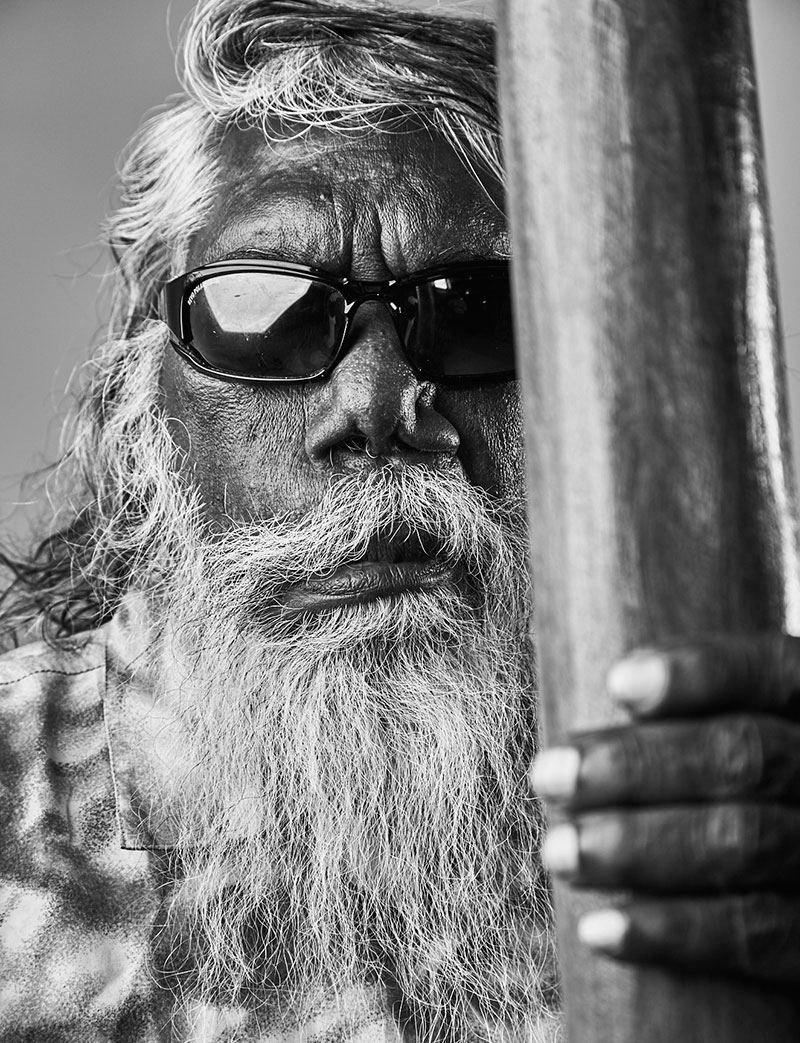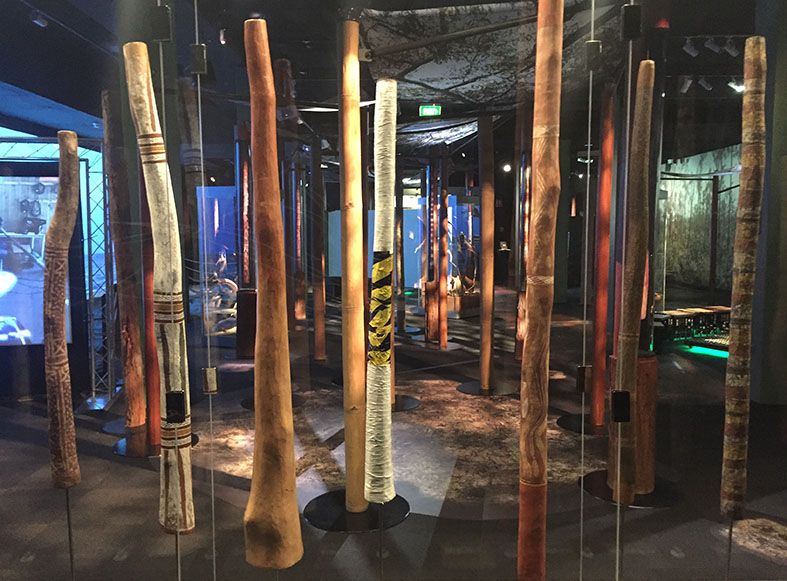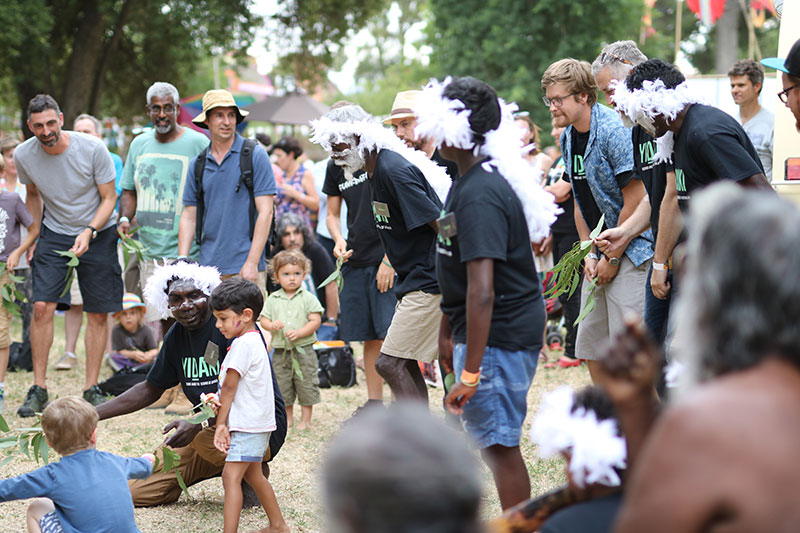.jpg)
The sound of the yidaki calls everyone together in unity (Djalu Gurruwiwi)
In the exhibition Yidaki: Didjeridu and the Sound of Australia at the South Australian Museum project curator John Carty proposes a new way of doing business, as collaboration, going beyond consultation, to promote the agency of Indigenous players. While Yidaki held a place in the 2017 Adelaide Festival Program under the visual arts banner, its traction goes well beyond the exhibition model and in turn the museum sector. What began as an exhibition based on the Museum’s significant didjeridu collection has become a multifaceted project.
The 160-year-old Museum holds the largest and most representative collection of ethnographic material on Australian Aboriginal heritage in the world, part of which is presented historically and thematically in the Australian Aboriginal Cultures Gallery across two floors within its eastern wing. While these often rich and beautiful displays are periodically rotated, the presentation varies little. With Yidaki in the temporary exhibition gallery a new approach was sought.
While the didjeridu has become a symbol of Indigenous Australia, this exhibition recognises the partnership with the Yolngu culture of Arnhem Land as the home of yidaki. The project’s key consultant was the leader of the Dhuwa moiety Galpu clan of North East Arnhem Land, Djalu Gurruwiwi, an internationally recognised master of the instrument.
On the opening Friday night of the Adelaide Festival on the Museum’s front lawns the community celebration included a ceremonial performance, the Mulka Project film screenings, the Bärra Band and a moving exchange of yidakis and club Guernseys between the Gurruwiwi family and Port Power AFL, Adelaide. Kaurna Elder Stephen Goldsmith and his son Jamie were an integral part of the exhibition having worked closely with the Yolngu people of Arnhem Land and particularly the Galpu clan and the Museum in the project’s development. Jamie performed the welcome to country, but also joined the Yolngu in their ceremony.

Over about an hour Djalu Gurruwiwi and his family gave a ceremonial performance, a bunggul, executing songs and dances belonging to their Galpu clan including Bärra the west wind which blows before the wet, Baywara, the lightning power and Wititj The Rainbow Serpent. The performers wore rainbow-coloured clothing to invoke the Rainbow Snake, their faces vibrantly painted in the Wititj design.
Such a ceremonial performance goes well beyond a public program or entertainment. The Galpu is one of numerous interconnected clans across Arnhem Land, each with authority over key ancestral figures related to their clan country. So here, through the Galpu song lines presented, with Gurruwiwi as our host and master of ceremonies, we were offered an insight into broader Yolngu culture. Beyond putting on a good show the performance was akin to “singing in” the exhibition, serving to both invoke the power of the Galpu clan and to bless its partner here – the Museum and, by extension, the non-Indigenous community.
Inside the museum, the exhibition is designed for the visitor to experience an Arnhem Land stringybark forest from which the yidaki are sourced. A stand of trees is installed with a fabric leafy canopy while the floor carries graphics conveying the tracks of a 4WD vehicle used to collect yidaki. That’s the backdrop for two thematic (and at times competing) threads in terms of exhibition content: one that is about the meaning and significance of yidaki in Yolngu society and the other to champion the didjeridu as a musical instrument.

We are shown the yidaki and its importance in Yolngu cultural life through Djalu’s narrative, “Djalu Talks”, outlining the exhibition’s theme and intentions. On a huge screen a storm brews signaling Bärra the pre-monsoon west wind, lightning strikes periodically throughout the space, videos by the Mulka Project focusing on the yidaki within Yolngu ceremony, and their making through “finding, shaping and painting” yidaki.
The exploration of the yidaki as an instrument of sound makes good use of innovative display models (vibration boards and yidaki sounds in the space, accessible on headphones, and through videos bands playing in an outdoor cinema). Some twenty of the 100-plus didjeridus in the Museum collection of the South Australian Museum are on display in the “Yidaki Showcase” and in the “Stringybark Forest” (installed within hollowed trees to highlight their source). A key aspect here is the documented interaction between Yolngu and the museum. Taken out of their climate-controlled storage over months a number of didjeridus were re-humidified and “woken up” (played) by the Gurruwiwi family on visits in the project development phase. Some of the instruments are over one hundred years old.
Standing before a finely incised slender bamboo instrument from the Port Darwin area, collected by Police Inspector Paul Foelsche before 1900 highlighted the interface of traditional Indigenous culture with the white establishment. A 1930s yidaki collected by Harold Sheperdson speaks to the mission era in Arnhem Land and the early days of an Aboriginal arts and crafts market. There are also two Yolngu instruments collected by Charles Mountford, presumably during the 1940s American Australian Scientific Exhibition to Arnhem Land, and a further example from the Lardil people of Mornington Island collected by Norman Tindale, an ethnologist from the South Australian Museum known for developing the notion of tribal boundaries and subsequent map. These culturally and historical objects of trade and core provenance in contact with Western institutions are shown next to a contemporary yidaki covered with hazard and gaffer tape, highlighting the expedience of contemporary music makers active in the world music scene.

This area of the exhibition highlighted some of the promised rarely seen diverse collection of treasures from the museum’s extensive collection but I found myself wanting to see more. Why not display as many as possible, and have made this a more central section of the exhibition? A single didjeridu beautifully lit in the centre of the space becomes a revered icon, a sacred manuscript and a hero object. Through the display of a multitude, carefully and elegantly spaced, the notion of both the breadth of the collection as well as the diversity within a class of object is conveyed. (The recent display of nineteenth-century shields at the Art Gallery of NSW and the early Papunya boards at the National Gallery of Australia are good examples.).
This project started with its yidaki collection – that is the object – and for me is the key here. While the Yidaki exhibition brochure tells us that this is not an exhibition about objects, I think there is great value in recognising and championing the sheer beauty and power of the object and its ability to speak volumes about its culture. More could have been achieved through also demonstrating the cultural context of these artefacts through highlighting the yidaki’s connection to other forms of material and visual culture, like ceremonial objects, regalia, body and bark painting.
That said, the reach achieved by harnessing the power of multimedia and performance to activate an immersive, inter-cultural space in dialogue with artists and communities is real. As is the sound of the instrument – the “Didjeridu and the Sound of Australia” represented in the exhibition title – going beyond the usual parameters of museum displays. A transporting moment, a focus zone that captures the sound, tone, timbre and vibration in relation to the shape and size of the particular didjeridu is discoverable in the didjeridu-embedded tree in the forest space, which upon approach activates an audio of Gurruwiwi playing. This audio environment, unpacking the extraordinary range of capabilities, extends to monitors in the corner of the exhibition space, where you can hear through headphones those collection recordings of the various woken up yidaki as well as some of the vast range of sounds standing in for the dog, walking, sitting, red kangaroo, west wind, white cockatoo, dolphin, bluetongue lizard and crocodile as well as insights into sounds and technique (“hard tongue”).
.jpg)
A further achievement of this exhibition was the impressive range of public and outreach programs through associated presenting partners. A floor talk by the museum collection staff focusing on the waking up of didjeridus was valuable in signalling collection research and the engagement with Yolngu (and on a broader scale with other Indigenous groups like the Kaurna, Ngarrindjeri, Mirning) also as a signal of an intended way forward for the museum. The Sprigg Lecture “The Didjeridu: An Australian Icon” given by ethnomusicologist Professor Aaron Corn, Director of the Centre of Aboriginal Studies in Music at Adelaide University (a Yidaki-supporting partner) centred on the powerful interface of research institutions. The collaborative concert program by Queensland didjeridu virtuoso William Barton with the Adelaide Symphony Orchestra played to a full and appreciative audience and orchestra, giving the Yidaki project reach into the music sector. There was also a strong and successful presence at WOMADelaide, the annual world music festival that is one of South Australia’s key cultural events. This year, the visiting Gurruwiwi family shared their culture through workshops, demonstrations and performance in the SAM discovery tent in the kidzone. One of a number of wonderful SAM and John Carty Instagram video posts spoke volumes for the impact – a non-Aboriginal boy of 5 or 6 intently danced with a group of Yolngu, following and imitating the steps, watching and learning and engaging, his impromptu participation welcomed and encouraged by the Yolngu.

The Yirrkala community in North East Arnhem Land has a long and strong history of active intercultural engagement (including the influential Yirrkala church panels, influential rock group Yothu Yindi and the annual Garma Festival). The Buku Larrnggay Mulka Centre is a leader in arts and culture with artists like Gunybi Ganambarr, whose work was a highlight of the last Asia-Pacific Triennial in Brisbane, also currently represented in The National in Sydney, and Nyapanyapa Yunipingu exhibiting in the Art Gallery of NSW for the “Embassy of Spirits”, as part of the 20th Biennale of Sydney. Their work comes with political punch, as represented in land claims for the historically significant bark petition against Bauxite Mining to Parliament and Big Barks, Saltwater: Yirrkala Bark Paintings of Sea Country, a Stokes Larrakitj project, as well as the ongoing Mulka Project (a multimedia archive to sustain and protect Yolngu knowledge and living cultural heritage).
Central to the success of Yidaki: Didjeridu and the Sound of Australia, Djalu Gurruwiwi is an entrepreneur, showman, world statesman, generous spiritual leader, master musician, video and collaborator (in his work with street artists and the musician Gotye on the film Westwind: Djalu’s Legacy). Such pervasive collateral filters right through the public performances for WOMAD, opening events on North Terrace in front of the Museum, as well as the sharing of culture with Port Power AFL (and thus with their fan base) along with the extensive multimedia in the exhibition itself. Future incarnations of the project might make even more of this evolving live element built into the exhibition and online space through social media activity to harness this dynamic, living culture.
.jpg)













